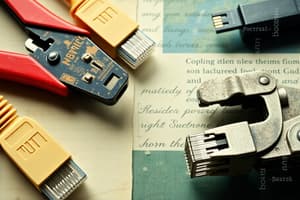Podcast
Questions and Answers
What is the primary purpose of a cable crimper?
What is the primary purpose of a cable crimper?
- To test the continuity of the cables.
- To spool cables for storage.
- To add connectors to the ends of cables. (correct)
- To cut cables to the desired length.
Which type of cables can cable crimpers be used on?
Which type of cables can cable crimpers be used on?
- Coaxial, twisted pair, and fiber cables. (correct)
- Twisted pair and fiber cables only.
- Only coaxial cables.
- Only fiber optic cables.
What happens to the copper wires during the crimping process?
What happens to the copper wires during the crimping process?
- They are bent without making contact.
- They are stripped of insulation.
- They are entirely removed from the connector.
- They are pushed into the RJ45 connector to establish a connection. (correct)
What feature of the RJ45 connector is essential for maintaining the cable's stability?
What feature of the RJ45 connector is essential for maintaining the cable's stability?
In the context of crimping, what does good crimping look like?
In the context of crimping, what does good crimping look like?
What is the characteristic of the sharp prongs on the RJ45 connector?
What is the characteristic of the sharp prongs on the RJ45 connector?
Why is it important to have a specially designed tool for crimping cables?
Why is it important to have a specially designed tool for crimping cables?
What would likely happen if a crimper does not push the prongs through the insulation correctly?
What would likely happen if a crimper does not push the prongs through the insulation correctly?
What tool is necessary for making certain types of measurements in networking?
What tool is necessary for making certain types of measurements in networking?
What is the purpose of a loopback plug in troubleshooting?
What is the purpose of a loopback plug in troubleshooting?
Which type of cable is a loopback cable NOT intended for?
Which type of cable is a loopback cable NOT intended for?
What is a physical network tap used for?
What is a physical network tap used for?
What is the function of a SPAN in networking?
What is the function of a SPAN in networking?
What distinguishes an active network tap from a passive network tap?
What distinguishes an active network tap from a passive network tap?
Which statement about crossover cables is accurate?
Which statement about crossover cables is accurate?
What essentially happens when a physical tap is installed between two devices?
What essentially happens when a physical tap is installed between two devices?
What limitation might be encountered when using a port mirror?
What limitation might be encountered when using a port mirror?
How does a loopback cable differ from crossover cables?
How does a loopback cable differ from crossover cables?
What is the purpose of an electrician's scissors, also known as cable snips?
What is the purpose of an electrician's scissors, also known as cable snips?
Which connector type is specifically used for category 5, category 6, and category 7 cables?
Which connector type is specifically used for category 5, category 6, and category 7 cables?
What does a Wi-Fi analyzer do?
What does a Wi-Fi analyzer do?
What equipment is needed to locate a specific cable among many in a data center?
What equipment is needed to locate a specific cable among many in a data center?
What does a punch down tool do when connecting wires to a punch down block?
What does a punch down tool do when connecting wires to a punch down block?
Why is it important to maintain the twist in ethernet cables?
Why is it important to maintain the twist in ethernet cables?
What information can a basic cable tester provide?
What information can a basic cable tester provide?
What does the inductive probe in cable identification do?
What does the inductive probe in cable identification do?
What is the primary use of a Wi-Fi analyzer in a crowded Wi-Fi space?
What is the primary use of a Wi-Fi analyzer in a crowded Wi-Fi space?
What is the best method for ensuring proper organization when using punch down blocks?
What is the best method for ensuring proper organization when using punch down blocks?
What kind of information does a cable tester typically NOT provide?
What kind of information does a cable tester typically NOT provide?
How does a tone generator work in cable tracing?
How does a tone generator work in cable tracing?
What is a disadvantage of working with punch down blocks?
What is a disadvantage of working with punch down blocks?
Which of the following is NOT a common use for tools mentioned in cable management?
Which of the following is NOT a common use for tools mentioned in cable management?
Flashcards
Cable Crimper
Cable Crimper
A tool used to securely attach connectors to the ends of cables.
RJ45 Connector
RJ45 Connector
A type of connector used to connect ethernet cables to devices, often found on network cards and routers.
Crimping
Crimping
The process of using a cable crimper to attach a connector to a cable.
Crimp Prongs
Crimp Prongs
Signup and view all the flashcards
Cable Termination
Cable Termination
Signup and view all the flashcards
Cable Stay
Cable Stay
Signup and view all the flashcards
Good Crimp
Good Crimp
Signup and view all the flashcards
Bad Crimp
Bad Crimp
Signup and view all the flashcards
What is a TDR?
What is a TDR?
Signup and view all the flashcards
What is a loopback plug?
What is a loopback plug?
Signup and view all the flashcards
What is a loopback cable used for?
What is a loopback cable used for?
Signup and view all the flashcards
What is a physical network tap?
What is a physical network tap?
Signup and view all the flashcards
What is a SPAN (Switched Port Analyzer)?
What is a SPAN (Switched Port Analyzer)?
Signup and view all the flashcards
What is a passive tap?
What is a passive tap?
Signup and view all the flashcards
What is an active tap?
What is an active tap?
Signup and view all the flashcards
What is a crossover cable used for?
What is a crossover cable used for?
Signup and view all the flashcards
How can you test a device's interface?
How can you test a device's interface?
Signup and view all the flashcards
Why is it important to analyze network traffic?
Why is it important to analyze network traffic?
Signup and view all the flashcards
Crimping Tool
Crimping Tool
Signup and view all the flashcards
Ethernet Cable Categories
Ethernet Cable Categories
Signup and view all the flashcards
Wi-Fi Analyzer
Wi-Fi Analyzer
Signup and view all the flashcards
Softwar-Based Wi-Fi Analyzer
Softwar-Based Wi-Fi Analyzer
Signup and view all the flashcards
Hardware-Based Wi-Fi Analyzer
Hardware-Based Wi-Fi Analyzer
Signup and view all the flashcards
Tone Generator
Tone Generator
Signup and view all the flashcards
Inductive Probe
Inductive Probe
Signup and view all the flashcards
Punch Down Block
Punch Down Block
Signup and view all the flashcards
Punch Down Tool
Punch Down Tool
Signup and view all the flashcards
Wire Twisting
Wire Twisting
Signup and view all the flashcards
Cable Tester
Cable Tester
Signup and view all the flashcards
Crosstalk
Crosstalk
Signup and view all the flashcards
Signal Loss
Signal Loss
Signup and view all the flashcards
Study Notes
Cable Crimping and Tools
- Cable crimpers are tools used to add connectors to cables, similar to pliers, but specifically designed for connectors
- Different crimpers exist for coaxial, twisted pair, and fiber optic cables
- This is a final step, usually performed after running cables
- Crimpers for twisted pair cables push prongs through insulation to connect copper wires inside
- RJ45 connectors are commonly used with twisted pair cables; they have prongs engaging the wires; the copper connections at the end connect to the device
- Crimping creates a solid connection of copper wires to the connector's prongs
- Cable crimpers securely fasten the connector to the cable
- Good quality cable cutters (electrician's scissors or cable snips) and strippers are also essential
- Wire type (Cat 5, Cat 6, Cat 7) affects connector type, use the correct connector for the cable
Wireless Network Troubleshooting
- Wireless networks use radio frequencies; a Wi-Fi analyzer is crucial for diagnosing issues
- Wi-Fi analyzers are software/hardware devices that identify occupied and available frequencies on a wireless network
- Useful for high-density Wi-Fi environments or understanding interference/signal strength
- These tools facilitate adjustments of antennas and network configurations
Cable Identification and Testing
- Tone generators and inductive probes (toner probes) are used to find cables in large bundles (data centers)
- Connect a tone generator to one end of a cable and use the inductive probe to find the cable, its sound indicates its signal
- This is effectively used to quickly isolate and find a specific cable.
- Cable testers perform continuity checks (if connections are complete)
- Tests if pins 1-8 are properly connected
- Identifies if wires are crossed/missing ensuring correct connections
Punch Down Blocks
- Punch-down blocks are used for permanent cable connections, specifically for multiple cables (data center, etc.)
- A specialized tool, the punch-down tool, is needed for this operation, cutting and neatly fastening multiple wires to the block
- Record-keeping on connections is important when using punch-down blocks
- Maintain the twists throughout the cable installation process
- Maintain accurate data and records when using these blocks.
Advanced Network Tools
- TDR (Time Domain Reflectometer) is a more complex tool for measuring signal loss or cable faults
- Loopback plugs send data back to the same interface, used to assess if there is an error with the physical device's interface
- Loopback plugs connect a device to itself, helping diagnose device problems.
Network Monitoring
- Network taps (passive and active) can capture data traversing a connection.
- Physical network taps are used to copy data between devices
- Switches also include functions to send data copies to a third-party (port mirror or SPAN)
- Use a protocol analyzer or monitor to check traffic between two or multiple devices
- Switch port analyzers (SPANS) temporarily copy network data to a separate interface.
Studying That Suits You
Use AI to generate personalized quizzes and flashcards to suit your learning preferences.
Description
Explore the essential tools and techniques for cable crimping in this quiz. Discover the different types of crimpers for coaxial, twisted pair, and fiber optic cables. Learn how to properly secure connectors like RJ45 and ensure quality connections for various wire types.



